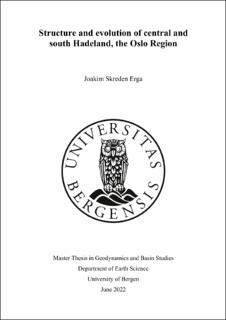| dc.description.abstract | The Oslo Region has been influenced by at least two major tectonic events: Contraction and formation of the Caledonian orogeny as a result of plate convergence and, later, extension and formation of the Oslo Graben in Permian. Hadeland, situated in the northern part of the region, has been of particular interest for geologist to understand the geological evolution of the Oslo Region. However, until recently, the folded and thrusted 425 Ma old sedimentary sequence which exhibits typical thin-skinned foreland structures has been difficult to map out in a desired quality due to poorly exposed outcrops. Also, the structural timing and evolution is not fully understood. Relatively new LiDAR data allow for diagnostic structural patterns to be exposed, and to review both LiDAR’s potential in bedrock mapping and Hadeland’s structural geology in a new light. Calcite samples have been obtained and dated utilizing their U-Pb relations in an attempt to uncover the structural evolution of the area as well as pinpointing exact dates for deformational events in the Oslo Region. Results from this thesis have produced a new 1:50 000 bedrock map covering central and south Hadeland. The map shows significant improvements to the existing map, clearly displaying the advantage provided by LiDAR data. Based on the new delineations, a geologic cross-section has been constructed, and new calculations of Caledonian shortening indicates a minimum of 30 % shortening of the affected strata by folding and thrusting. Seven out of 34 mounts sent for U-Pb dating proved datable but produced relatively inconclusive results with high uncertainties. Only one sample with an estimated age of 236 ± 39 Ma correlated with the Permian rifting. In summary, this thesis has shown the efficiencies and strengths of LiDAR data as a tool in bedrock mapping, but also some of the shortcomings. The new and improved bedrock map points toward a larger displacement caused by thrusting than previously thought, a finding which is likely due to the improved delineations introduced by LiDAR data in mapping. In addition, total shortening of the area is postulated to be in the range of 38-45 %, indicating that differences in shortening in the mid-Ordovician to Silurian successions might be larger from north to south than previously estimated in the region. While the majority of dated calcite samples are interpreted to be from reactivation of faults and fractures in the latest 35 Ma, successful dating of the Permian Rift indicates that the method may still have validity in the Oslo Region, but it requires a larger and more comprehensive field campaign. | |
